Aztec Sun God
The Aztec sun was a warrior god fighting daily battles, and the only thing stopping skeletal demons from eating everyone. To get the Aztec world, you have to get their Aztec gods, and the Aztec sun god was one of the most important of all. For a deeper look at the beliefs and rituals that powered this faith, explore the Aztec Religion page.
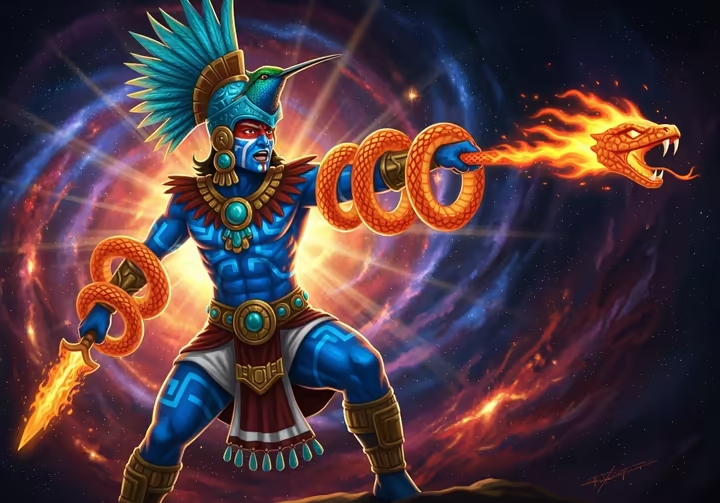
Who Was the Aztec Sun God?
The job of Aztec sun god wasn't as straightforward as you'd think. It was a role held by two main figures, Tonatiuh and Huitzilopochtli, who were later merged together in a clever bit of religious and political engineering.
The Two Faces of the Aztec Sun God
The Aztecs actually had two main gods filling the role of Aztec sun god. First was Tonatiuh (toh-nah-tee-uh), an older sun god inherited from other cultures whose name meant "He Who Goes Forth Shining." His job was to be the sun itself, the ruler of the current cosmic era, the Fifth Sun.
Then there was Huitzilopochtli (weets-ee-loh-poch-tlee), the "Hummingbird of the South." He was the special war god of the Mexica tribe (the Aztecs) and would become their ultimate Aztec sun god.
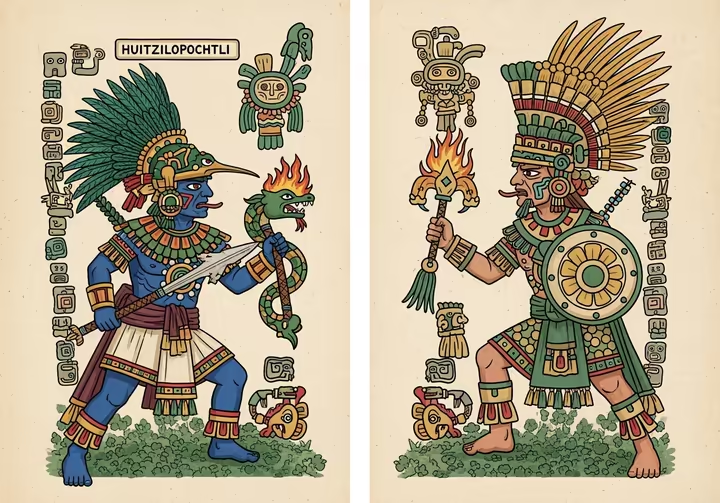
As the Mexica built their empire, their war god got a big promotion. An influential advisor named Tlacaelel basically mashed Huitzilopochtli and Tonatiuh together, making their tribal war god the one true Aztec sun god. This was a smart political move.
This turned the Mexica's wars for land and tribute into a sacred mission. War now also served to capture victims for sacrifice, providing the hearts and blood needed to feed the Aztec sun god. The Mexica became the "People of the Sun," whose job was to keep the universe running.
The Aztec Sun God's Violent Birth
Huitzilopochtli's new gig as the Aztec sun god came with a wild origin story full of family drama. This isn't a gentle bedtime tale. It's about betrayal and a warrior's birth on a mythical mountain called Coatepec, or Serpent Mountain.
The Myth of Coatepec
On this mountain lived the earth goddess Coatlicue ("She of the Serpent Skirt"), her daughter Coyolxauhqui (the moon), and 400 sons, the Centzon Huitznahua (the southern stars). One day, a ball of hummingbird feathers floated down and touched her, and poof... she was pregnant. Her kids were not pleased.
They felt dishonored and, led by their furious sister Coyolxauhqui, they plotted to kill their own mother.
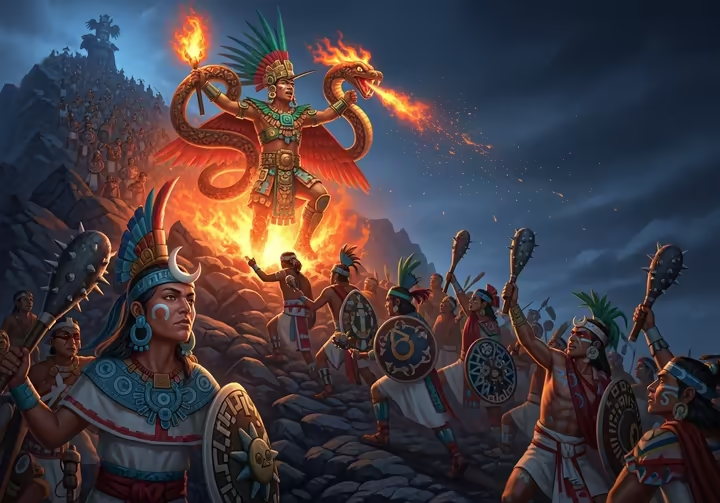
As the 400 star-gods charged up the mountain, a voice from Coatlicue’s womb told her not to worry. Just as they reached the top, the future Aztec sun god Huitzilopochtli burst out, not as a baby, but as a full-grown warrior swinging his weapon, the *Xiuhcoatl* or "Fire Serpent."
He immediately killed his sister Coyolxauhqui, chopped her up, and threw her body down the mountain. He then hunted down his 400 brothers, slaughtering most of them and scattering the rest across the sky.
This whole bloody story explains the daily job of the Aztec sun god. His birth is the sun appearing, his victory over his sister is the sun chasing away the moon, and the massacre is the sun snuffing out the stars. It set a violent rule, the world's order depended on a daily, divine battle.
The Aztec Sun God's Cosmic Role
The daily fight of the Aztec sun god was just one piece of a bigger cosmic drama. The Aztec universe ran on the endless conflict between two creator brothers, Quetzalcoatl (light and order) and his rival Tezcatlipoca, the "Smoking Mirror" (darkness and chaos).
An Old Rivalry
Tezcatlipoca was a powerful god of the night sky, sorcery, and destiny. Their rivalry was a cosmic push-and-pull that created and destroyed entire worlds.
According to the "Legend of the Five Suns," the world had already been created and destroyed four times. Each era, or "Sun," ended when the brothers had a falling out.
One time, Tezcatlipoca turned into a jaguar and had everyone eaten; another time people got turned into monkeys. The next two worlds were destroyed by fire and a massive flood.
Paying the Price
The Aztecs lived in the Fifth Sun, our current era. It began at the sacred city of Teotihuacan when the humble god Nanahuatzin jumped into a divine fire to become the new sun, Tonatiuh. But there was a problem, he was too weak to move.
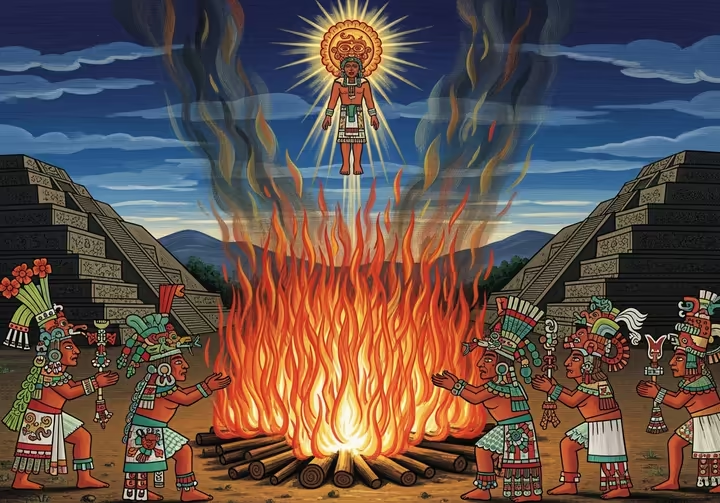
The cosmos stood still until the other gods sacrificed themselves, offering their hearts and blood to give the new sun energy. This sacrifice created a huge debt. Humanity now had to repay the gods for their existence.
Human sacrifice, for the Aztecs, was a cosmic necessity, a "debt-payment" called *nextlahualli*. The best payment was human blood (*chalchihuatl*) and the heart (*teyolia*). This was the fuel needed to power the Aztec sun god on his daily journey.
Failing the Aztec Sun God
And if they failed to pay up? Total annihilation. The Aztecs believed that if the Aztec sun god weakened, skeletal star demons called the *tzitzimimeh* would descend from the sky to devour all of humanity.
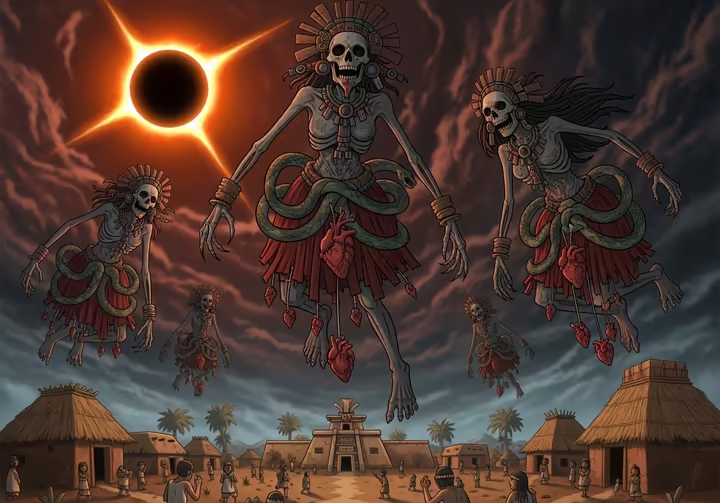
These female deities, with skull-like faces and clawed hands, were chaos just waiting to happen. Solar eclipses were terrifying moments, seen as a direct attack on the Aztec sun god by the *tzitzimimeh*. This constant threat made the whole sacrifice thing seem pretty urgent.
The Aztec Sun God in Stone
You can see this hungry Aztec sun god in their art, especially the famous Sun Stone. People call it a calendar, but it’s really a cosmic map and a slick piece of political advertising.
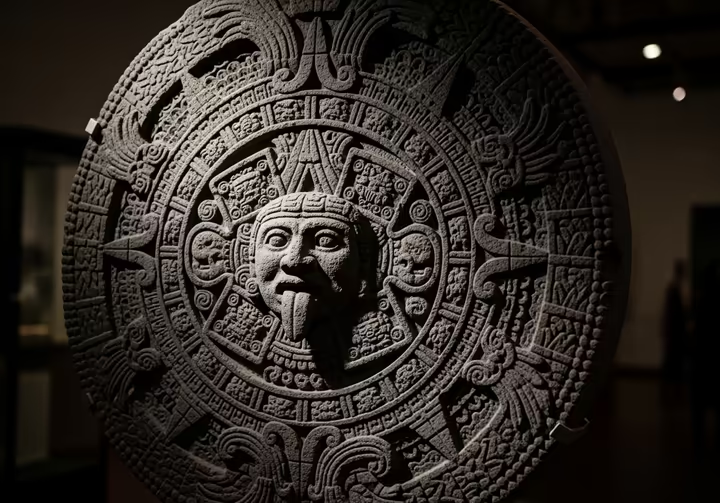
At the center is a terrifying face with a flint knife for a tongue, thirsty for blood. Two clawed hands grip human hearts, just in case you missed the point. This central face represents the cosmic forces the Aztec sun god battled.
The Aztecs loved layered meanings, so the face could represent multiple things at once. It is framed by the glyph "4-Movement," the name of our era, which they believed would end in earthquakes. Around that are symbols for the four previous, destroyed suns.
The whole disk is circled by two *Xiuhcoatl*, or Fire Serpents, that carry the Aztec sun god across the sky. By carving this, the Mexica were basically declaring, "We're the center of the universe, and our ruler is in charge."
Worshipping the Aztec Sun God
Worship of the Aztec sun god was the heart of religious life in the capital, Tenochtitlan. Its center was the Templo Mayor, or Great Temple.
A Temple for the Aztec Sun God
This giant pyramid had two shrines on top. The southern temple, painted red for war, was for Huitzilopochtli, the Aztec sun god. The northern one, painted blue for water, was for Tlaloc, the rain god. This war-and-farming, sun-and-rain design showed how the Aztecs saw the world.
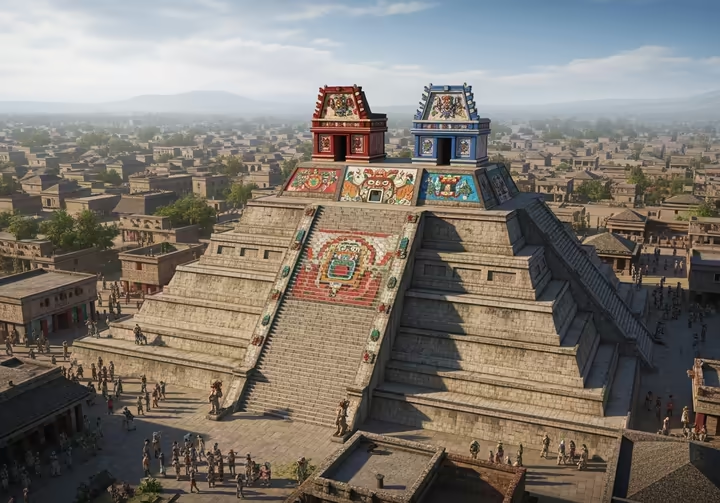
The whole pyramid was a model of Coatepec, the mountain where the Aztec sun god was born. At the bottom of his stairs was a huge stone disk showing his chopped-up sister, Coyolxauhqui.
During sacrifices, a victim's heart was removed at the top. Their body was then rolled down the stairs to land on his sister's stone. This was a powerful show for everyone watching, the Aztec sun god had won again.
The Aztec Sun God's Birthday Party
The most important festival for the Aztec sun god Huitzilopochtli was Panquetzaliztli ("Raising of the Banners"), a 20-day party for the sun's rebirth at the winter solstice. A key ritual was making a large statue of the Aztec sun god out of *tzoalli*, a dough of amaranth seeds and honey.
This dough figure of the Aztec sun god was paraded through the city like it was alive. Then, it was broken into pieces and eaten by everyone in an act of communion. All through the festival, war captives were sacrificed at the Templo Mayor.
The Aztec Sun God's Afterlife
When the Spanish arrived in the 16th century, the Aztec world collapsed. The Templo Mayor was torn down, and worshipping Huitzilopochtli was banned. But the story of the Aztec sun god didn't disappear, it just changed.
From Aztec Sun God to Holiday
Panquetzaliztli, the Aztec sun god's birthday party, happened around the same time as Christmas. Spanish priests saw a chance to merge the two. They blended the Aztec festival with the Christmas story, creating *Las Posadas*, a nine-day procession still celebrated in Mexico.
The Aztec Sun God on the Flag
But the most famous legacy of the Aztec sun god is on the Mexican flag. The Aztec sun god Huitzilopochtli told the migrating Mexica to build their city where they saw an eagle on a cactus eating a snake. That image is now the coat of arms for Mexico.
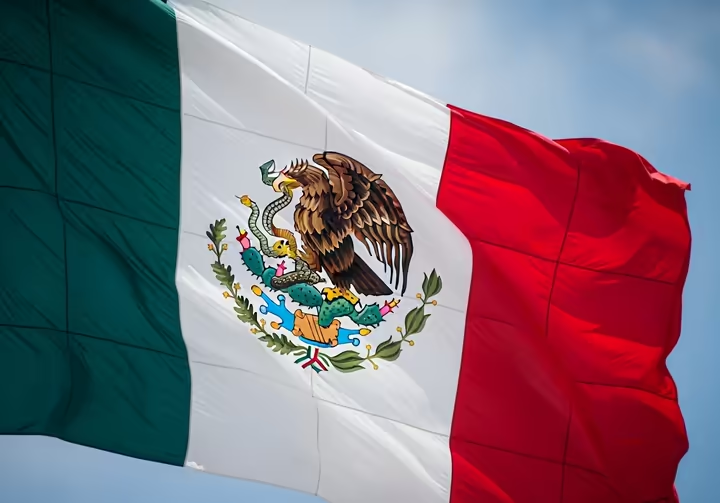
For the Aztecs, the eagle represented their Aztec sun god, and the cactus was their sacred city. The snake is a bit of a mystery, it might have been a Spanish addition. In the Aztec world, snakes were actually positive symbols of wisdom and the earth.
Christian missionaries gave it a new spin, the eagle was "good," and the snake was "evil." It wasn't the original meaning, but it stuck. Today, the eagle on the cactus is a national symbol of Mexican pride.
So the Aztec sun god Huitzilopochtli is no longer worshipped with hearts and blood. But as the eagle on the flag, he's still a proud symbol for an entire nation.